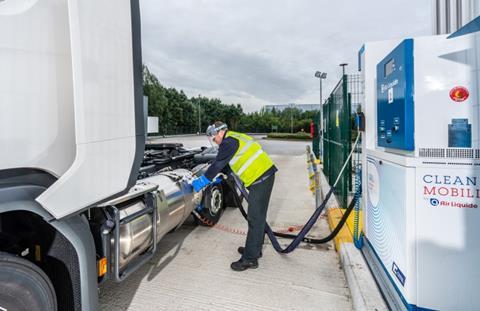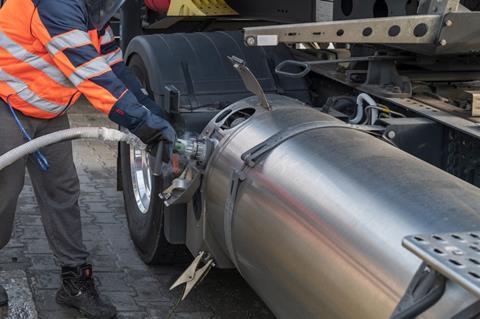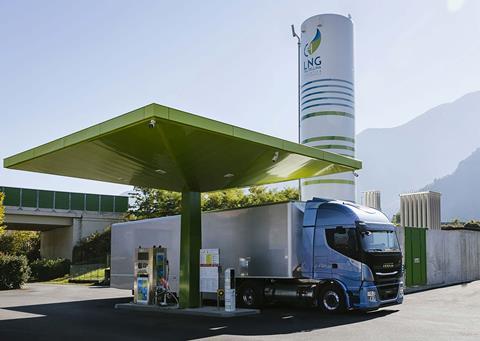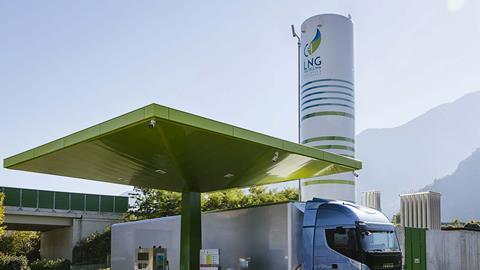What is the technology?
The terms biomethane, biogas, bio CNG and bio LNG are all used; despite ‘bio’ and ‘natural’ being distinct terms with distinct meanings these terms can sometimes be used interchangeably adding confusion.
But ignoring the bio part for now, methane is a compound of hydrogen and carbon - just like petrol, diesel, propane or butane – accept it’s the simplest hydrocarbon, consisting of one carbon atom and four hydrogen atoms. Sometimes it’s known as natural gas, especially when it heats our radiators or cooks our food at home.

In our homes, gas is delivered via pipeline and its pressure is regulated appropriately for heating and cooking applications. To store gas, in a vehicle fuel tank for example, it is normally compressed to 200 bar, this is known as compressed natural gas (CNG).
Higher pressures of CNG at around 250 bar can be used in certain vehicles with an appropriately certified fuel tank. The higher pressure increases the energy density and therefore facilitates a better vehicle range.
Gas can be made more energy dense by cooling it down to extremely low temperatures when it becomes a liquid or more correctly a cryogenic liquid. In this form, the term liquified natural gas (LNG) is used. LNG is stored in an insulated fuel tank to keep the liquid in its cryogenic state.
Circling back to the bio part of biomethane - this simply means that the gas comes from sustainable sources. Biomethane comes from the processing of organic waste in a process called anaerobic digestion (AD) and anaerobic digesters can be seen on agricultural sites across the country.
Where and how is biomethane produced?
The route that gas takes to end up in a vehicle’s fuel tank is different for CNG and LNG. For LNG vehicles, the fuel is delivered by road tanker and is collected from the Isle of Grain in Kent in the UK where LNG is imported from the various places across the globe that produce it.
The imported LNG is stored and dispensed to road tankers for fuel use, or is regasified and sent through the pipeline grid for distribution.

CNG can be produced by tapping into the National Grid system and compressing the gas up to 200 bar, so CNG filling stations can exist where there is a gas grid to connect to.
The gas in the UK National Grid comes from three main sources:
- Fossil gas imported via pipeline (in the main this comes from Norway)
- Fossil gas imported via LNG in ships (in the main LNG is imported from Qatar and the USA)
- Bio-gas injected directly to the grid from anaerobic digestion
Because the sources are combined into a single system (the grid), the gas that is extracted can be a mixture of all three sources, so some will be fossil gas and some will be bio-gas.
Through a system called Mass Balancing, this allows the purchase of bio-bas from the grid up to the amount of bio-gas deposited into the system. The same process is used for fair trade coffee, fair trade chocolate and renewable electricity. So long as the amount of renewables bought is balanced to the amount of renewables sold, it is somewhat irrelevant that these sources are mixed together in the distribution system.
Because the Mass Balancing system is so useful, a certification system exists that allows renewable products to be traded across countries effectively balancing a much wider renewable distribution system.
Biomethane in trucks
Two different engine technologies are available - spark ignition and compression ignition - and are offered by different vehicle manufacturers. Scania and Iveco offer only spark ignition engines in their gas vehicles, while Volvo offers only compression ignition gas vehicles.
Spark ignition
Spark ignition engines are able to operate using CNG or LNG, and vehicles can be specified with CNG or LNG fuel tanks. Whether CNG or LNG tanks are specified, the engine runs on compressed gas and the LNG vehicles must heat up the liquid so that it expands into compressed gas before entering the engine. Once in the engine, the compressed gas is ignited by a spark plug, just like a petrol engine in a car. The engines use 100% gas, they have a power, torque and rev profile similar to a petrol engine (faster revving than a diesel), and they deliver relatively high power compared to the torque output.

The higher revving spark ignition engine is a little less efficient than a diesel engine (like a petrol car is less efficient than a diesel car) and delivers a little less torque. These are characteristics of the spark ignition technology regardless of how the fuel is stored either as a gas (CNG) or as a liquid (LNG).
Spark ignition vehicles from Iveco and Scania are available in various artic and rigid configurations, although from a more limited model range compared with diesel models. Gas vehicles are more expensive than diesel models by around 20%-30% on average, LNG being more expensive than CNG as the cryogenic tank adds cost compared to the CNG tank.
The additional capital cost of gas vehicles can normally be offset with a reduced fuel cost as gas is historically cheaper than diesel. The payback time will vary depending on the annual mileage and the length of time the vehicle is kept for but generally it is paid off within three years, and from then on savings are the norm.
Compression ignition
Compression ignition relies on a fuel that combusts under pressure rather than the fuel being ignited by a spark. Once inside the engine, the fuel is always in gas form and as gas does not ignite under pressure like diesel does, the Volvo engine uses a small amount of diesel to ignite the gas.
The diesel ignites under pressure and once the diesel is ignited the gas is injected and ignites too. The incorporation of diesel allows the engine to perform and behave like a traditional diesel engine with higher efficiency and torque than the spark ignition engines. It’s for this reason that the Volvo technology requires LNG - the injection pressure of gas into the engine is around 300 bar, therefore it is not possible to use CNG as it is stored at only 200 bar.

The ratio of gas to diesel falls between 90:10 and 95:5 depending on the engine revs. The inclusion of diesel makes fuelling a little more complex and potentially more expensive, however because the engine is inherently more efficient, the additional expense often evens out. In fact, the compression ignition engine generally costs less to run than the spark ignition engines, although due to the engine needing a gas and a diesel injection system, the base vehicle normally carries a premium over diesel of around 40% compared to the 20%-30% premium for spark engines.
Volvo’s compression ignition gas vehicles are available in various artic and rigid models currently.
Environmental considerations
From an environmental position, biomethane can reduce operational CO2 emissions by up to 90%, and while biomethane does not offer zero tailpipe emissions, it is possible to save more CO2 through this route than current electric vehicles.
Tailpipe emissions are generally lower than diesel, but they are not zero due to the combustion process. Internal combustion engines (ICE) are due to be banned from either 2035 for up to 26 tonne vehicles, or 2040 for vehicles over 26 tonnes.
Vehicle cost
The choice between spark ignition and compression ignition technology can come down to several factors. The dominant factor is normally the return-on-investment period – higher mileage operations and higher weight operations are often more cost effective with compression ignition as the operational cost saving pays back the additional capital faster.
Conversely, spark ignition vehicles often pay back faster on lower mileage and lighter weight operations as the lower relative capital cost and higher operational costs are factored in.
There is no definitive answer as the operational characteristics will determine the cheapest solution. Some fairly sophisticated calculations and/or a demo vehicle are needed to determine the most cost-effective gas engine type for a given operation.
Fuel cost
There are some very large fleets using biomethane, either in its CNG or LNG form, and some smaller operations too. It lends itself better to fixed route operations due to the limited number of fuel stations, but there are some tramping operations utilising gas too.
The cost advantages have reduced over recent times with energy price inflation, but the underlying business case is supported by a reduced fuel duty incentive put in place by the UK government to encourage adoption. This duty benefit is currently in place until 2032 which is at least two replacement cycles for most operators. What happens after 2032 is unclear, but it is fairly safe to reason that diesel will be disincentivised for the rest of its days.
Infrastructure
As with most alternative fuels or energy sources, there are some infrastructure considerations and implications. Several CNG and LNG public access fuel stations exist and there are also privately operated sites which can often be accessed with prior arrangement.
For CNG fuel stations a (normally high pressure) gas main must be present nearby. The gas is drawn from the grid and compressed into storage tanks for dispensing into vehicles. CNG requires no special equipment for the driver, and the refuelling process in very simple.

LNG stationd can exist almost anywhere as the fuel is delivered by road tanker and stored in large cryogenic tanks for dispensing into vehicles. The process for fuelling with LNG requires the driver to use PPE in the form of cryogenic gloves to protect from the cold, and a visor or goggles to protect the eyes in the event of splashing ice particles.
As with bunkering diesel, a minimum of around 20 vehicles is necessary to make the operation of an onsite refuelling facility cost effective. Public infrastructure can obviously be accessed with just one vehicle, although there may be some re-routing required to access a station.
Summary
The popularity of gas technologies across Europe proves the business case for gas as an alternative fuel, however some limitations on vehicle type availability and infrastructure have limited its wider adoption.
Gas cannot solve the transport emissions problem alone, primarily as there is not enough biomethane to power the number of trucks on the road, and there will never likely be enough as it is produced from organic wastes of which there is limited supply.
However, biomethane offers a ready to deploy solution to CO2 emissions and can have a big impact on total emissions as reductions start immediately – no need to continue to emit CO2 with diesel while waiting for some other technology to mature into a practical alternative.
In simple terms, biomethane can save money and CO2 emissions, so if the technology works for your fleet operation there is very little downside.











